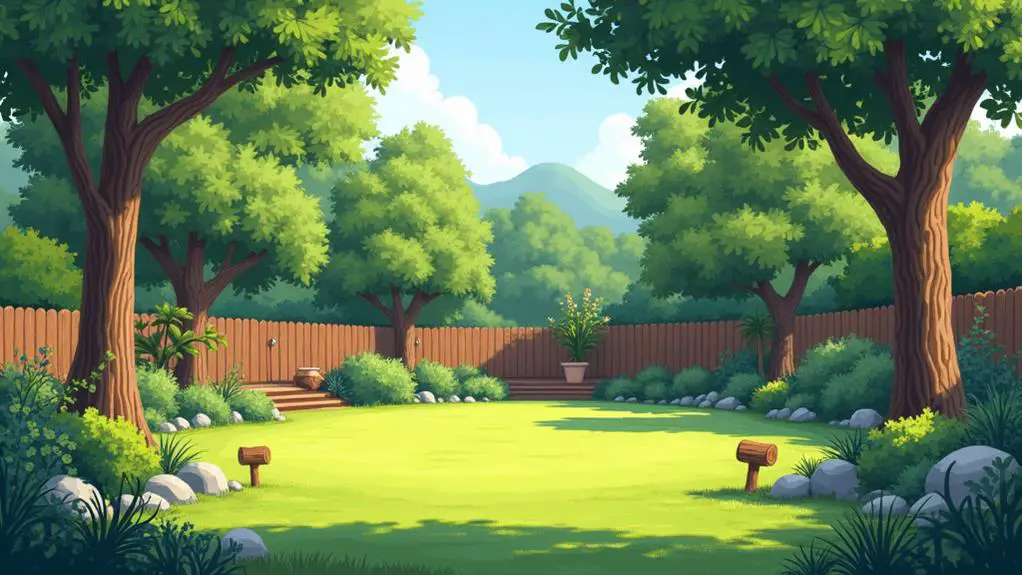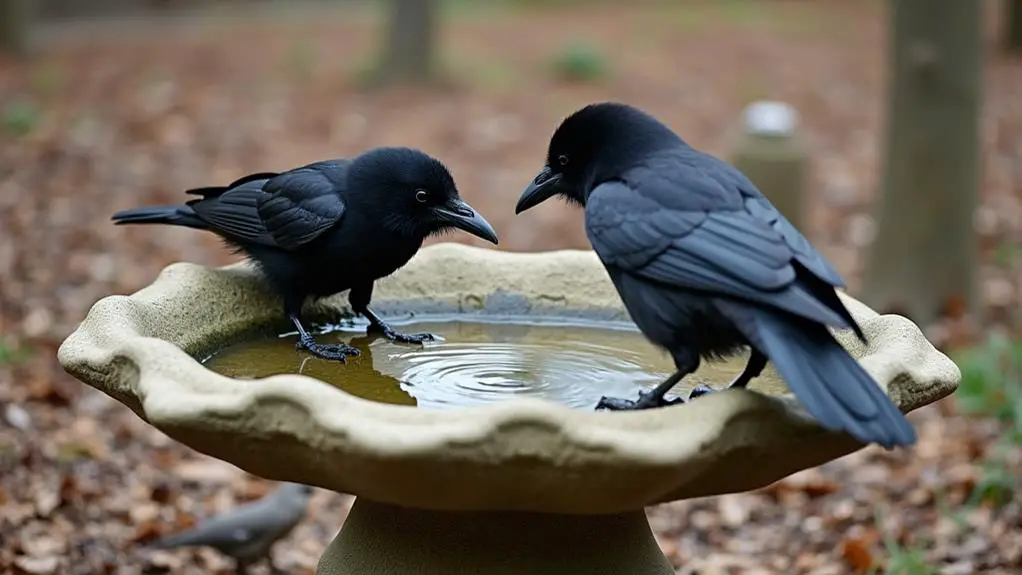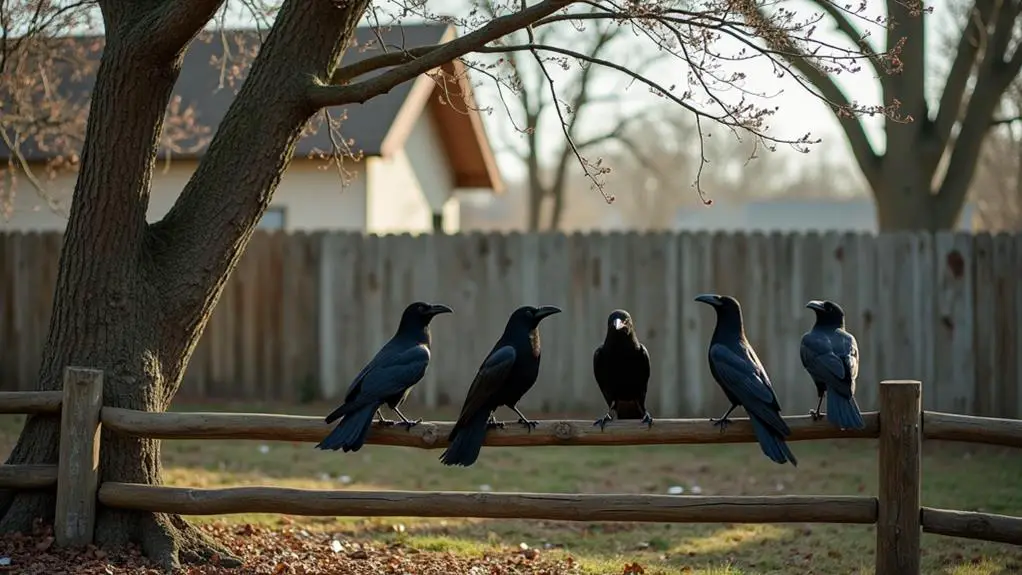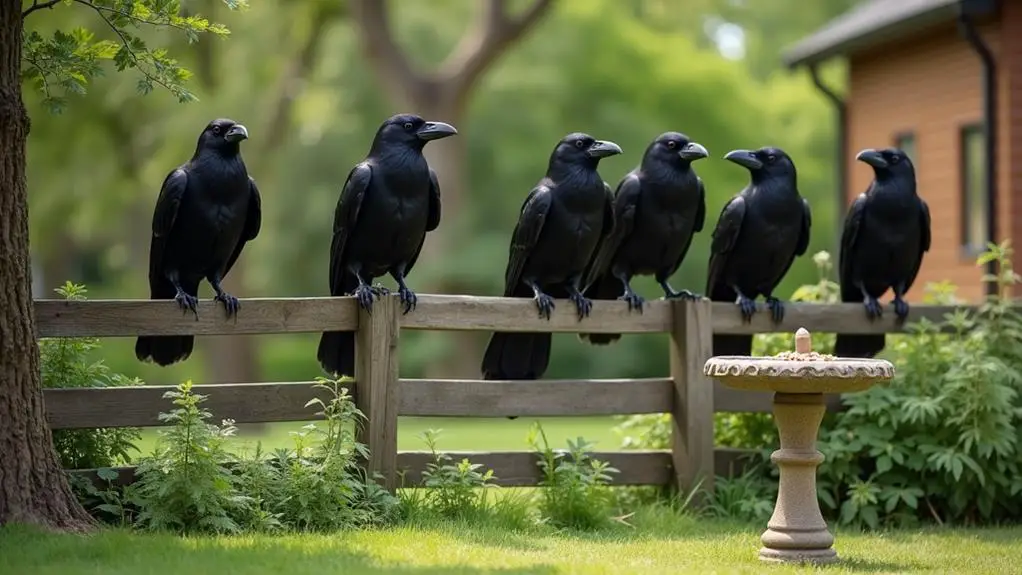You’re about to become the most popular crow magnet in the neighborhood, attracting a murder of hooded crows that’ll make your yard the go-to hangout spot. But before you’re overwhelmed by their intelligent, curious nature, you’ll need to create an environment that meets their unique needs. It’s not just about tossing some bread crumbs their way; hooded crows require a thoughtful approach to entice them to stay. By understanding what drives these fascinating birds, you can craft a backyard oasis that will keep them coming back for more – and we’ll explore exactly how to do that.
Key Takeaways
- Create a crow-friendly yard by incorporating native plants, open spaces, and minimal obstacles to attract hooded crows.
- Offer high-energy food sources like nuts, seeds, and fruits, and provide clean and well-stocked feeders and birdbaths.
- Incorporate shelter and perching options like tree cavities, dead branches, and native shrubs with dense foliage.
- Ensure yard safety by removing hazardous materials, choosing crow-proof plants, and minimizing noise pollution.
- Use visual attractants like shiny objects, bright colors, and moving objects to draw hooded crows’ attention.
Crow-Friendly Yard Layout

When designing a crow-friendly yard layout, consider the birds’ natural foraging habits and social behavior.
Hooded crows are intelligent and social birds that thrive in environments that mimic their natural habitats. By incorporating native plants, you’ll be providing a familiar and welcoming space for these birds. Native plants will attract local insects, which are a primary food source for hooded crows.
In terms of spatial layout, consider the corner spaces of your yard.
Hooded crows are known to congregate in these areas, using them as vantage points to survey their surroundings. By leaving these spaces open and uncluttered, you’ll be creating an inviting spot for the birds to roost and socialize.
Avoid placing bird feeders or baths in these areas, as they can disrupt the birds’ natural behavior.
Instead, focus on creating a seamless transition between your yard and the surrounding environment. By doing so, you’ll be creating a crow-friendly yard layout that will attract these intelligent birds and provide them with a comfortable space to thrive.
Providing Food for Hooded Crows
You’ll want to stock up on high-energy foods like nuts, seeds, and fruits to attract hooded crows to your backyard.
These intelligent birds are particularly fond of cracked walnuts, hazelnuts, and sunflower seeds, as well as ripe fruits like cherries and blueberries.
Crow’s Favorite Foods
Hooded crows are opportunistic omnivores, which means they’ll eat almost anything they can find.
However, you can attract them to your backyard by offering their favorite foods. They’re particularly fond of crow treats like nuts, seeds, and fruits.
You can place these treats on a bird feeder or scatter them on the ground. Sunflower seeds, cracked corn, and fruits like apples and blueberries are all great options.
You can also offer mealworms or suet to provide a high-energy food source. Bird seeders with large, sturdy perches can accommodate hooded crows‘ size and strength.
Avoid using seeders with small openings or fragile perches, as they may not be accessible to these birds.
Remember to keep the feeders clean and well-stocked to ensure the crows keep coming back. You can also try offering table scraps like bread, potatoes, or carrots, but make sure they’re fresh and free of mold or bacteria.
Feeding Ground Rules
Regularly, feeding hooded crows requires a thoughtful approach to ensure a safe and healthy experience for both the birds and humans involved.
You’ll want to establish clear feeding ground rules to avoid overcrowding, aggressive behavior, and dependency on humans.
To maintain a respectful and healthy relationship with the crows, follow these guidelines:
- Crow etiquette: Avoid sudden movements or loud noises, which can startle the birds and lead to aggression. Instead, move calmly and speak softly to create a peaceful atmosphere.
- Feeding schedules: Establish a regular feeding schedule to condition the crows to visit your backyard at specific times. This helps prevent over-reliance on humans and maintains a natural foraging behavior.
- Food distribution: Scatter food evenly across the feeding area to prevent dominance and aggression among the crows. This also encourages foraging and exploration.
- Hygiene and cleanliness: Regularly clean and disinfect feeding areas to prevent the spread of diseases and maintain a healthy environment for both humans and crows.
Water Sources for Crows

You’ll want to provide water sources that cater to the unique needs of hooded crows, which are drawn to shallow, calm water.
Consider installing crow-friendly birdbaths with gentle slopes and rough surfaces, allowing the birds to easily access and bathe in the water.
Additionally, incorporating natural water features, such as ponds or streams, into your backyard design can also attract these intelligent birds.
Crow-Friendly Birdbaths
Perched at the edge of your yard, crows await a reliable water source, their piercing gazes scanning the landscape for a spot to quench their thirst.
As a crow enthusiast, you can capitalize on this need by providing a crow-friendly birdbath that meets their specific requirements.
When it comes to birdbath placement, consider positioning it in an open area with minimal vegetation, allowing crows to approach and depart easily.
Avoid placing it near predator-attracting structures or under trees that might obstruct their flight path.
To ensure bath water quality, follow these guidelines:
- Change the water regularly to prevent bacterial growth and maintain cleanliness.
- Use a birdbath with a rough surface or add rocks to facilitate crow preening and bathing.
- Position the birdbath in a spot that receives partial shade to reduce algae growth.
- Avoid using birdbaths with deep water, as crows prefer shallow water for bathing and drinking.
Natural Water Features
Beyond birdbaths, incorporating natural water features into your yard can be a game-changer for attracting hooded crows.
These intelligent birds are drawn to water sources that mimic their natural habitats. Consider incorporating rocky edges, which provide a natural perching area for crows to access water without having to wade in.
Winding streams or small ponds with gentle currents can also create a sense of movement, making the water more attractive to crows. The sound of gently flowing water can be particularly enticing, as it signals the presence of a reliable water source.
When designing your natural water feature, aim to create a variety of depths and water levels to accommodate different types of birds. Additionally, consider incorporating native vegetation around the water feature to provide shelter and foraging opportunities for crows.
Shelter and Perching Options
Providing shelter and perching options is crucial for attracting hooded crows to your backyard, as these birds are highly adaptable and opportunistic.
Hooded crows require a place to rest, hide from predators, and survey their surroundings, making shelter and perching options essential for their survival.
You can create an inviting environment by incorporating the following features:
- Tree cavities: Hooded crows often nest in tree cavities, so consider maintaining or creating hollows in mature trees.
- Dead branches: Dead branches provide perching sites and can serve as lookout points for crows.
- Native shrubs: Planting native shrubs with dense foliage can provide shelter and protection from harsh weather.
- Perching posts: Installing perching posts or poles can offer crows a place to land and observe their surroundings.
Creating a Crow-Safe Environment

As you create an inviting environment for hooded crows, it’s equally important to ensure their safety within your backyard. One crucial aspect of crow safety is the plants you choose to have in your yard. Some plants can be toxic to crows, so it’s essential to opt for crow-proof plants that won’t harm them.
| Hazardous Materials | Safe Alternatives |
|---|---|
| Oleander | Native flowers like sunflowers or daisies |
| Rhododendron | Berry-producing shrubs like blueberries or raspberries |
| Avocado | Fruit trees like apple or cherry |
Another critical consideration is the presence of hazardous materials in your yard. Remove any potential threats, such as pesticide-treated seeds, sharp objects, or loose wires. Ensure that your trash cans have secure lids to prevent crows from rummaging through them and ingesting harmful materials. By taking these precautions, you’ll create a safe haven for hooded crows to visit and thrive in.
Using Visual Attractants
Visual cues play a significant role in attracting hooded crows to your backyard.
Hooded crows are intelligent birds that rely heavily on visual stimuli to navigate their environment and find food sources.
By incorporating the right visual attractants, you can increase the likelihood of attracting these fascinating birds to your yard.
Some effective visual attractants to consider include:
- Crow decoys: Place life-like crow decoys in strategic locations around your yard to create the illusion of a crow gathering. This can be particularly effective during breeding season when crows are more social.
- Shiny objects: Hooded crows are drawn to shiny objects, which they often associate with food or potential threats.
Hang shiny objects like aluminum foil, CDs, or reflective tape from trees or a fence to catch their attention.
– Bright colors: Use bright colors like red, blue, or yellow to create a visually appealing environment.
You can incorporate these colors into bird feeders, planters, or other yard decorations.
– Movement: Create movement in your yard by using wind chimes, spinning bird decorations, or other kinetic objects that can catch the attention of passing crows.
Making Your Yard Crow-Accessible

Making Your Yard Crow-Accessible
About three-quarters of a hooded crow’s day is spent foraging for food, making access to a reliable food source a top priority.
To capitalize on this behavior, you’ll need to ensure your yard is crow-accessible. Start by mapping your yard to identify areas that can be optimized for crow foraging.
Take note of the terrain, vegetation, and existing food sources. This will help you establish ground rules for crow-friendly landscaping.
When mapping your yard, consider the crow’s preference for open spaces with minimal obstacles.
Remove any debris or clutter that may hinder their movement. You should also identify areas with existing food sources, such as fruit trees or berry bushes, and consider supplementing these with crow-specific feeders or tables.
Maintaining a Crow-Welcoming Space
By incorporating crow-specific features into your yard, you’ve taken the first step toward creating a crow-welcoming space;
now, it’s essential to maintain it. Hooded Crows are intelligent and social birds that thrive in environments with minimal disturbance.
To ensure they keep visiting your yard, focus on reducing noise pollution and creating crow-free zones.
- Minimize noise: Avoid placing noisy bird feeders or wind chimes near crow-attracting areas, as loud sounds can scare them away. Instead, opt for quiet, crow-friendly alternatives.
- Designate crow-free zones: Create areas in your yard where crows can’t access, such as near pet areas or gardens, to reduce potential conflicts.
- Maintain a clean environment: Regularly clean up food waste and debris to prevent attracting other birds or pests that might compete with Hooded Crows for resources.
- Monitor and adapt: Observe crow behavior in your yard and adjust your maintenance strategy accordingly.
FAQs: Hooded Crows
Do Hooded Crows Get Along With Other Bird Species in the Yard?
You’ll observe that hooded crows often exhibit complex flocking behavior, establishing bird hierarchies that can lead to dominance over other species, but they can coexist peacefully with some species, especially those that don’t compete for similar resources.
Can I Keep Hooded Crows as Pets in My Backyard?
As you ponder keeping hooded crows as pets, remember that their wild nature shines like a beacon, warning you: these birds aren’t domesticated, and their behavior demands respect. Check local pet licensing laws, which often prohibit keeping wild crows as pets, prioritizing their freedom and yours.
Are Hooded Crows Protected by Law in My Area?
You should research local regulations regarding hooded crows’ conservation status in your area, as their protection varies by region; it’s essential to understand the laws governing their treatment to ensure you’re not inadvertently harming or harassing these birds.
How Do I Deter Hooded Crows From Raiding My Trash Cans?
As you navigate the urban jungle, you’re stalked by a clever thief, always on the lookout for an easy score. To outsmart the cunning crow, you’ll need to secure your trash cans with lids that fit snugly, like a puzzle piece, to prevent raids and keep your waste under wraps.
Can I Attract Hooded Crows to My Yard if I Live in an Apartment?
As an urban dweller, you can attract hooded crows to your apartment balcony by installing balcony feeders specifically designed for corvids, offering their preferred food sources, such as nuts and seeds, in a clean and safe environment.
Conclusion
By incorporating these elements, you’ve cracked the code to attracting hooded crows to your backyard. Remember, consistency is key – keep your space clean, quiet, and well-stocked, and the crows will flock to your haven. Don’t count your chickens before they hatch, but with time and patience, you’ll be enjoying the company of these intelligent birds in no time. With a little effort, you can create a thriving crow community that will leave you in awe.













